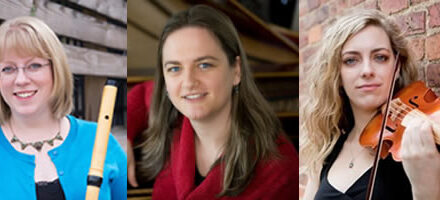The UNCW Office of Cultural Arts presents a dynamic calendar of events each year, the majority of them music. This performance by Bridgman-Packer Dance stood out both for being a dance performance and for the visual intensity of its presentation.
Bridgman-Packer have garnered numerous distinctions, including a 2008 Guggenheim Fellowship and grants from the National Endowment for the Arts. They have performed at such internationally-known locales as Spoleto Festival USA, Jacob’s Pillow Dance Festival, and New York City’s Lincoln Center.
Their program consisted of just two works, both choreographed and performed by Myrna Packer and Art Bridgman. The first was titled Under the Skin. One could say that the show started while the lights were still up, as somewhat edgy music – rhythmically suggestive of ragtime but more like modern pop and yet also more dissonant – was being played while the audience waited for the performance to begin. There was a sudden, almost comic stop to the music, and then the performance began with projections of rising geometric shapes which were superimposed on the dancers themselves.
The combination of sometimes multi-layered projections on the dancers was the essential characteristic of the performance. The variety and imaginativeness in combining moving pictures with bodily movement was energizing and compelling. The projections were sometimes shapes, sometimes letters such as Latin or Hebrew. They moved vertically and diagonally, calling forth different visual perspectives. In the second scene of the set, the lighting turned lurid red. Packer was the focus of humorous clothing projections, which changed her look sometimes almost moment by moment. She and Bridgman somewhat comically mirrored each other’s movements and then confounded that with her woman’s torso over a man’s projected legs. Later, Bridgman danced with a female figure in a red dress superimposed behind him and the two dancers, via projections, went in and out of the curtain backdrop. Eventually the stage was populated by a small crowd of dancers, all multiplied projections of the two soloists.
The result was that the performance was in reality a dual show of movement in dance and light. The level of imagination and invention remained consistently high, with new episodes and interactions creating continuous interest. Bridgman and Packer are top-notch dancers who brought energy and humor, as well as precise control, to their movements. The title of the piece presumably alludes to the clothing perambulations of the dancers, some of which showed a good deal of skin and also revealed skin in different ways. Under the Skin was also embodied by the music, which was consistently driving and rhythmic.
The second number, titled Voyeur, is based on the paintings of Edward Hopper. The set was remarkably simple: a large thick cardboard sheet six or eight feet high, bent into panels, and with window-like cutouts. Bathed in changing pictures, both on and behind the panels, coming from multiple projectors, this basic apparatus was transformed into multi-layered scenes, and the nexus of a whole range of interactions. Hopper liked to ride the elevated subway lines of New York and scan around him, including through people’s windows, for subjects to paint. This performance brought that to life, via a perspective that was always through or around the “windows” created by the set. Also brought vividly to life in the projections were the isolating angles of Hopper’s paintings, which set people and objects at a distance from one another, even if they are adjacent.
Hopper’s elevated trains were evoked a good deal, with a perhaps too portentous rumbling, suggesting fear as much as the thematic alienation of the city. Before that, however, the piece began in silence. That was a large, even welcome change from the continuous energy of the previous music, and it also set a meditative atmosphere for the mostly quiet sounds which accompanied Voyeur. At other points there was the sound of many footsteps on a sidewalk, and of the surf at the beach. Soft jazz music, characteristic of the period when Hopper worked, wove in and out. One scene brought a genuinely lyrical accompaniment, while in another, there was no music for an extended period. A visually arresting moment came in the return from the beach, where there was little movement by the dancers, to the city, where the projected cityscape rolled by continuously in a kaleidoscope of images.
Through all of this, the two dancers took on a variety of characters who connected and disconnected in a range of ways. The multiple layers of visual and body movement created an engrossing piece and highlighted the artistic range of the performers.
A nice touch came at intermission, when the audience was invited on to the stage to move within the set for the upcoming performance of Voyeur. One could see changing projections both of the city and of the people moving in and out of its visual range. That turned this dynamic multi-media show into something of an interactive event as well.
This program will be repeated on Saturday evening the 15th, once again in the Mainstage Theatre of the Cultural Arts building on the campus of UNCW. For details, see the sidebar.











